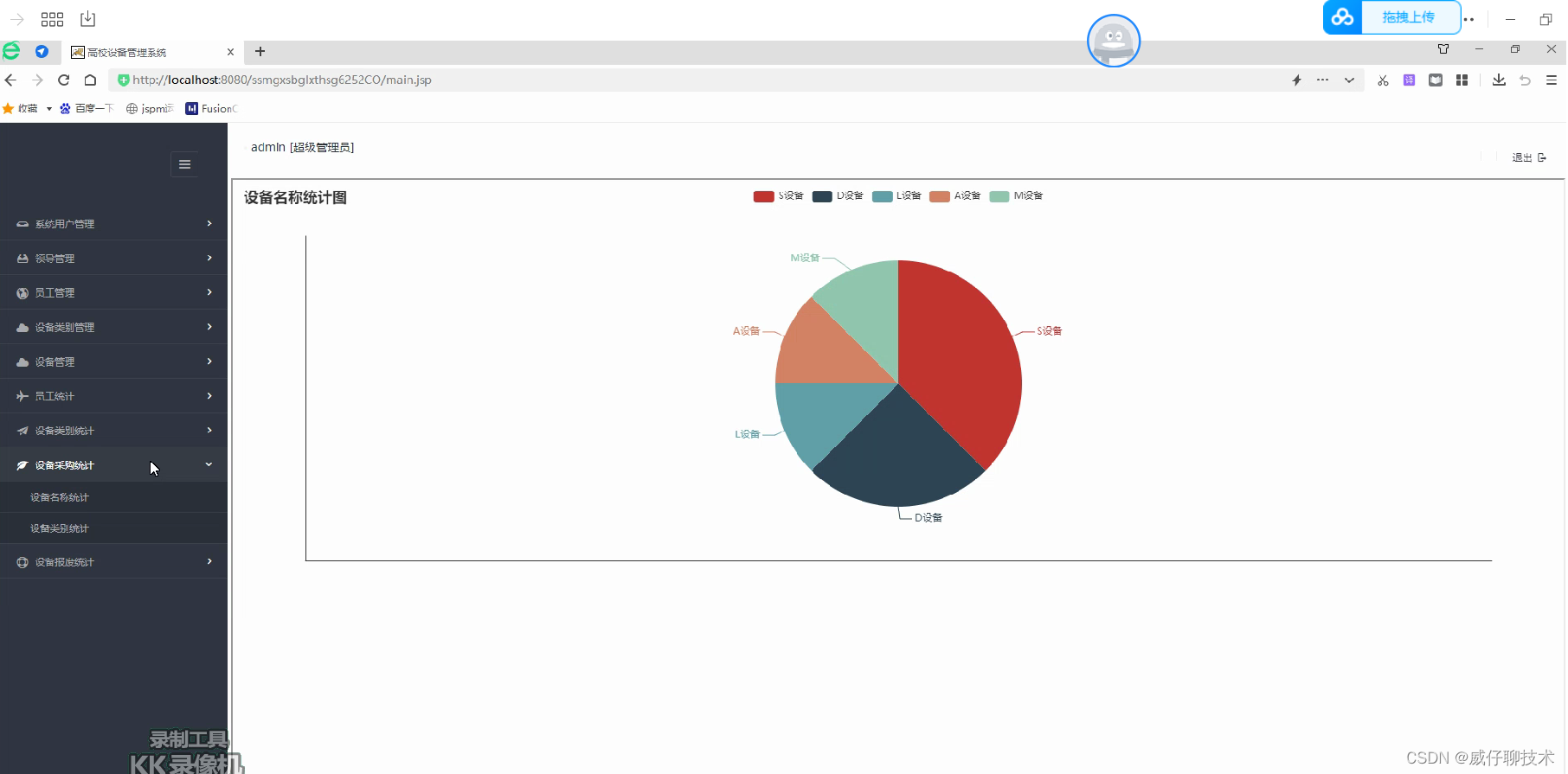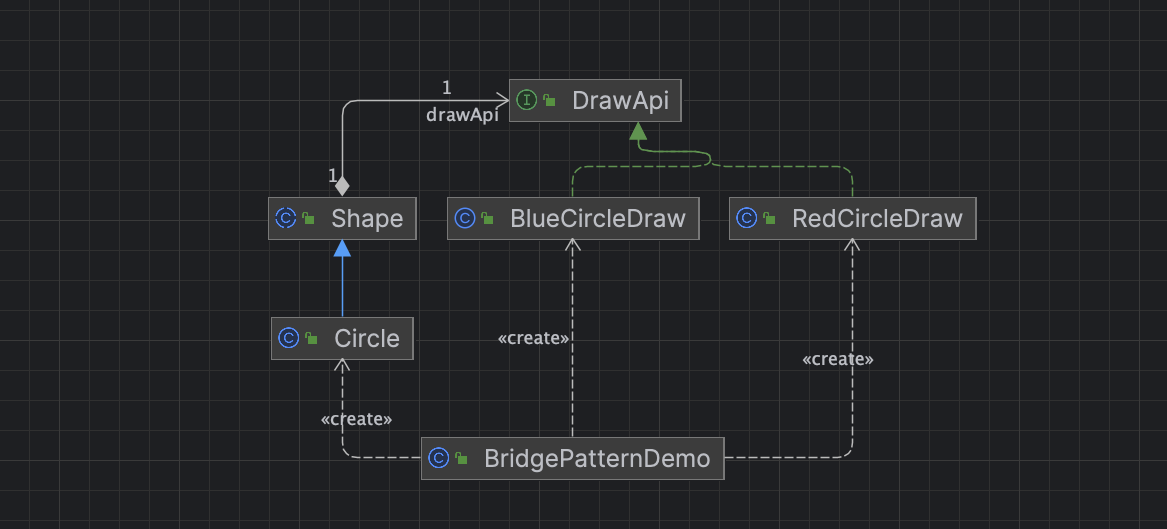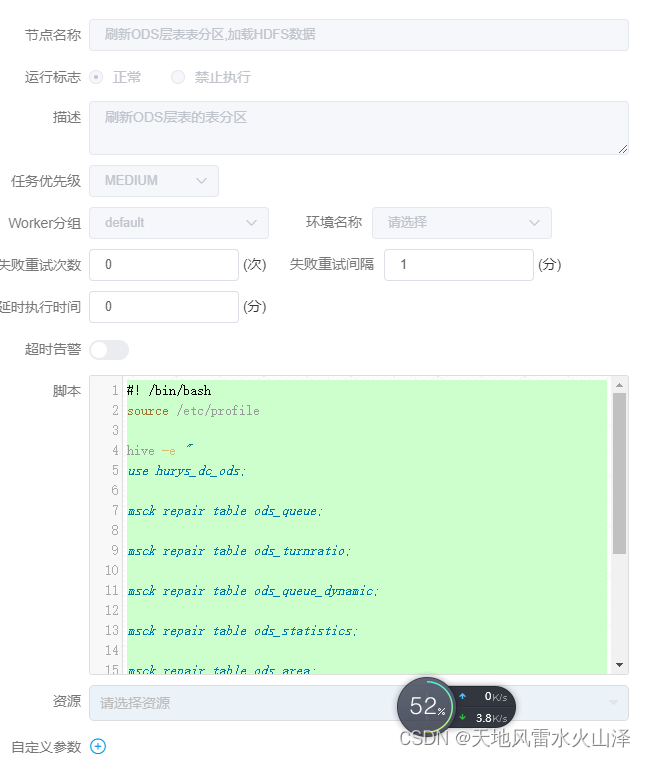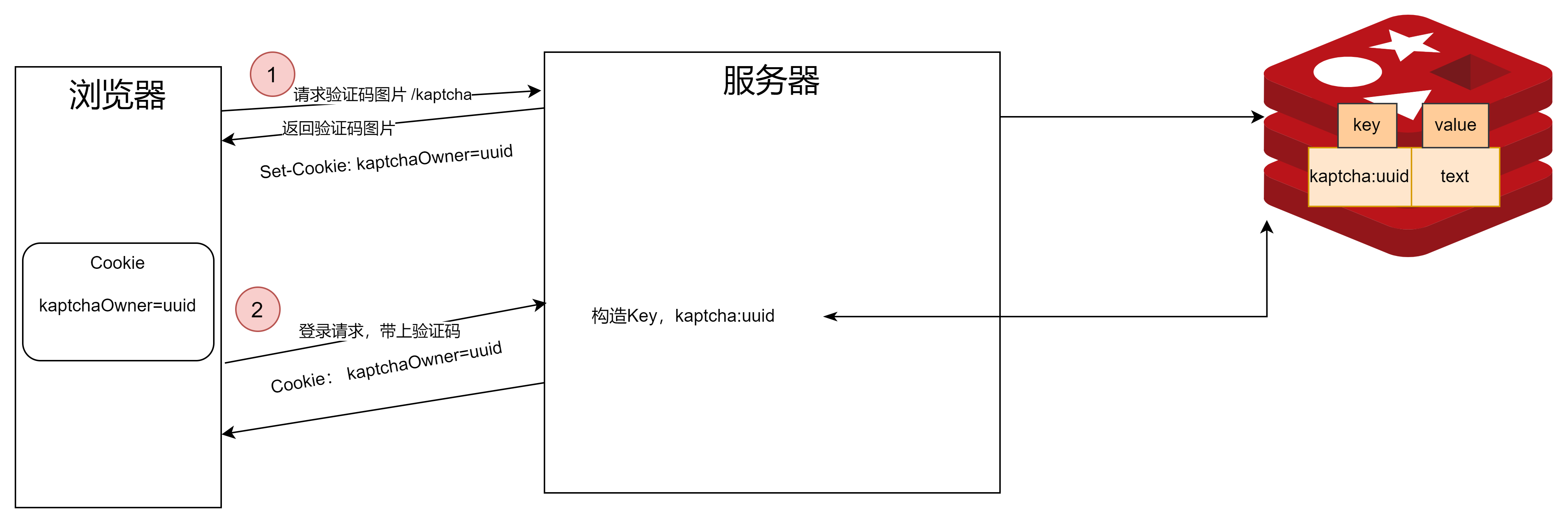摘要
高校是培养人才的重要场所,拥有大量的设备和器材,如实验室设备、学生宿舍设备、教学设备等,这些设备的管理对于高校事业的顺利发展起着至关重要的作用。随着高校信息化建设的不断深入,高校设备管理已逐渐成为学院日常教学环节中不可获取的重要的工作之一。目前,高校设备管理工作仍有很大的改善提升空间,一些高校设备管理存在着设备管理不到位、信息不及时、设备利用率低等问题。因此,设计开发一种基于 Java 技术的高校设备管理系统,具有重要的实际意义。
高校设备管理系统可以实现设备的快速定位、查询、管理,避免了繁琐的手动管理,通过使用设备管理系统,管理员可以轻松地实现设备的采购申请发起、报废申请审批等操作,极大地提高了日常办公效率。高校设备管理系统作为高校设备管理工作的重要支撑,具有对设备进行全面管理、合理调配、有效使用的能力,可以提高设备的利用率,并且对于高质量的教学科研活动和提升科技管理水平均起到至关重要的作用。
本次高校设备管理系统的实现过程,它的开发使用B/S结构即浏览器和服务器结构框架,前端采用Java 开发语言,数据库使用了Mysql数据库,论文具体内容包括系统的需求分析、设计原理与实现过程。本次设计采用了经典的 Model-View-Controller (MVC) 架构体系,充分考虑了日常设备管理的需要,提供合理有效的解决方案,旨在提高高校设备管理运行效率的同时,也为高校信息化建设作出贡献。本文结合系统开发流程,详细阐述了此次高校设备管理系统的研究背景、设计理念、模型结构,同时简略介绍了开发使用的相关技术,并对系统概要设计、系统实现与系统测试等进行了详细的说明。
关键词:高校;教学设备;设备管理;Java
网站设计
系统登录界面

员工管理

设备管理

设备采购统计

设备报废统计

相关技术
项目框架技术是一种软件开发方法,通过将常见的开发需求和解决方案预设为可重复使用的框架,来提高开发效率、简化开发过程和降低开发成本。框架技术通过提供一组通用的编程规范和约定,使得开发人员可以快速创建特定类型的项目,而不必重复编写相同的代码。
将展MVC系统架构是一种软件设计模式,用于开发基于Web的应用程序。MVC代表Model-View-Controller(模型-视图-控制器),其核心思想是将应用程序分为三个主要组件:模型、视图和控制器。
Model:应用程序中数据的表现形式,负责存储和处理数据。在MVC架构中,称为Model。
View:用户与应用程序进行交互的界面。在MVC架构中,称为View。
Controller:应用程序的逻辑部分,负责将用户的请求路由到适当的模型和视图,并处理响应。在MVC架构中,称为Controller。
通过将应用程序分成三个组件,并定义它们之间的正确通信方式,MVC使得应用程序更加模块化和可维护,并且使得新功能的添加更加容易。此外,MVC还提高了代码的可重用性,并提高了代码的可测试性。MVC模式已经成为许多Web应用程序的标准设计模式。
SSM是指Spring+SpringMVC+MyBatis这三个框架的整合,它们是用于Java Web应用开发的三个流行框架。
Spring是一个高效的Java企业级开发框架,主要用来处理Java应用程序框架中的IoC(控制反转)和AOP(面向切面编程)等方面的问题,能够有效地降低应用程序开发的复杂度。
SpringMVC是Spring框架中的一部分,它能够帮助开发人员更加容易地构建Web应用程序,并提供了非常好的扩展性。
MyBatis是一个流行的持久化框架,它提供了对关系型数据库进行访问的简单、易用的API,能够有效地解决JDBC在开发过程中遇到的问题。
三个框架的整合,可以使开发人员的编程效率更高、代码的重复性更小、出错率更低,同时可以更容易地维护和扩展应用程序。
部分代码
package com.controller;
import java.io.File;
import java.io.IOException;
import java.sql.Timestamp;
import java.util.ArrayList;
import java.util.HashMap;
import java.util.List;
import java.util.Map;
import java.io.PrintWriter;
import javax.annotation.Resource;
import javax.servlet.http.HttpServletRequest;
import javax.servlet.http.HttpServletResponse;
import javax.servlet.http.HttpSession;
import org.springframework.stereotype.Controller;
import org.springframework.ui.ModelMap;
import org.springframework.web.bind.annotation.RequestMapping;
import org.springframework.web.bind.annotation.RequestParam;
import org.springframework.web.multipart.MultipartFile;
import com.entity.Shoucangjilu;
//import com.chengxusheji.po.News;
import com.server.ShoucangjiluServer;
import com.util.PageBean;
import net.sf.json.JSONObject;
@Controller
public class ShoucangjiluController {
@Resource
private ShoucangjiluServer shoucangjiluService;
//
@RequestMapping("showShoucangjilu.do")
public String showShoucangjilu(int id,ModelMap map,HttpSession session){
/* Map<String,Object> bmap=new HashMap<String,Object>();
bmap.put("uid", id);*/
// map.put("blist", shoucangjiluService.getAll(bmap));
map.put("shoucangjilu", shoucangjiluService.getById(id));
return "read";
}
@RequestMapping("addShoucangjilu.do")
public String addShoucangjilu(HttpServletRequest request,Shoucangjilu shoucangjilu,HttpSession session){
Timestamp time=new Timestamp(System.currentTimeMillis());
//Users u=(Users)session.getAttribute("user");
/*if(u==null||u.equals("")){
return "redirect:showIndex.do";
}else{*/
shoucangjilu.setAddtime(time.toString().substring(0, 19));
shoucangjiluService.add(shoucangjilu);
session.setAttribute("backxx", "添加成功");
session.setAttribute("backurl", "shoucangjiluList.do");
return "redirect:postback.jsp";
//return "redirect:shoucangjiluList.do";
/*}*/
}
// 处理编辑
@RequestMapping("doUpdateShoucangjilu.do")
public String doUpdateShoucangjilu(int id,ModelMap map,Shoucangjilu shoucangjilu){
shoucangjilu=shoucangjiluService.getById(id);
map.put("shoucangjilu", shoucangjilu);
return "shoucangjilu_updt";
}
// 后台详细
@RequestMapping("ShoucangjiluDetail.do")
public String ShoucangjiluDetail(int id,ModelMap map,Shoucangjilu shoucangjilu){
shoucangjilu=shoucangjiluService.getById(id);
map.put("shoucangjilu", shoucangjilu);
return "shoucangjilu_detail";
}
// 前台详细
@RequestMapping("scjlDetail.do")
public String scjlDetail(int id,ModelMap map,Shoucangjilu shoucangjilu){
shoucangjilu=shoucangjiluService.getById(id);
map.put("shoucangjilu", shoucangjilu);
return "shoucangjiludetail";
}
//
@RequestMapping("updateShoucangjilu.do")
public String updateShoucangjilu(int id,ModelMap map,Shoucangjilu shoucangjilu){
shoucangjiluService.update(shoucangjilu);
return "redirect:shoucangjiluList.do";
}
// 所有List
// @RequestMapping("shoucangjiluList.do")
// public String shoucangjiluList(ModelMap map,HttpSession session){
// map.put("list", shoucangjiluService.getAll(null));
// map.put("clist", shoucangjiluService.getAll(null));
// return "shoucangjilu";
// }
// 分页查询
@RequestMapping("shoucangjiluList.do")
public String shoucangjiluList(@RequestParam(value="page",required=false)String page,
ModelMap map,HttpSession session,Shoucangjilu shoucangjilu, String username, String xwid, String ziduan, String biao){
/*if(session.getAttribute("user")==null){
return "login";
}*/
if(page==null||page.equals("")){
page="1";
}
PageBean pageBean=new PageBean(Integer.parseInt(page), 15);
Map<String, Object> pmap=new HashMap<String,Object>();
pmap.put("pageno", pageBean.getStart());
pmap.put("pageSize", 15);
if(username==null||username.equals("")){pmap.put("username", null);}else{pmap.put("username", username);}
if(xwid==null||xwid.equals("")){pmap.put("xwid", null);}else{pmap.put("xwid", xwid);}
if(ziduan==null||ziduan.equals("")){pmap.put("ziduan", null);}else{pmap.put("ziduan", ziduan);}
if(biao==null||biao.equals("")){pmap.put("biao", null);}else{pmap.put("biao", biao);}
int total=shoucangjiluService.getCount(pmap);
pageBean.setTotal(total);
List<Shoucangjilu> list=shoucangjiluService.getByPage(pmap);
map.put("page", pageBean);
map.put("list", list);
session.setAttribute("p", 1);
return "shoucangjilu_list";
}
@RequestMapping("shoucangjiluList2.do")
public String shoucangjiluList2(@RequestParam(value="page",required=false)String page,
ModelMap map,HttpSession session,Shoucangjilu shoucangjilu, String username, String xwid, String ziduan, String biao,HttpServletRequest request){
/*if(session.getAttribute("user")==null){
return "login";
}*/
if(page==null||page.equals("")){
page="1";
}
PageBean pageBean=new PageBean(Integer.parseInt(page), 15);
Map<String, Object> pmap=new HashMap<String,Object>();
pmap.put("pageno", pageBean.getStart());
pmap.put("pageSize", 15);
pmap.put("username", (String)request.getSession().getAttribute("username"));
if(xwid==null||xwid.equals("")){pmap.put("xwid", null);}else{pmap.put("xwid", xwid);}
if(ziduan==null||ziduan.equals("")){pmap.put("ziduan", null);}else{pmap.put("ziduan", ziduan);}
if(biao==null||biao.equals("")){pmap.put("biao", null);}else{pmap.put("biao", biao);}
int total=shoucangjiluService.getCount(pmap);
pageBean.setTotal(total);
List<Shoucangjilu> list=shoucangjiluService.getByPage(pmap);
map.put("page", pageBean);
map.put("list", list);
session.setAttribute("p", 1);
return "shoucangjilu_list2";
}
@RequestMapping("scjlList.do")
public String scjlList(@RequestParam(value="page",required=false)String page,
ModelMap map,HttpSession session,Shoucangjilu shoucangjilu, String username, String xwid, String ziduan, String biao){
/*if(session.getAttribute("user")==null){
return "login";
}*/
if(page==null||page.equals("")){
page="1";
}
PageBean pageBean=new PageBean(Integer.parseInt(page), 15);
Map<String, Object> pmap=new HashMap<String,Object>();
pmap.put("pageno", pageBean.getStart());
pmap.put("pageSize", 15);
if(username==null||username.equals("")){pmap.put("username", null);}else{pmap.put("username", username);}
if(xwid==null||xwid.equals("")){pmap.put("xwid", null);}else{pmap.put("xwid", xwid);}
if(ziduan==null||ziduan.equals("")){pmap.put("ziduan", null);}else{pmap.put("ziduan", ziduan);}
if(biao==null||biao.equals("")){pmap.put("biao", null);}else{pmap.put("biao", biao);}
int total=shoucangjiluService.getCount(pmap);
pageBean.setTotal(total);
List<Shoucangjilu> list=shoucangjiluService.getByPage(pmap);
map.put("page", pageBean);
map.put("list", list);
session.setAttribute("p", 1);
return "shoucangjilulist";
}
@RequestMapping("deleteShoucangjilu.do")
public String deleteShoucangjilu(int id,HttpServletRequest request){
shoucangjiluService.delete(id);
String url = request.getHeader("Referer");
return "redirect:"+url;
}
}
可行性分析
可行性分析是指在系统开发过程中对项目的可行性进行评估,分析系统是否具有可行性、可行性程度如何,以及实施该系统是否有必要等问题的过程。常见的可行性分析主要有硬件可行性、软件可行性、技术可行性、操作可行性、安全可行性。
硬件可行性分析
从硬件方面来看,该系统要求服务器性能较好,需要较大的运算和存储空间,同时需要较快的网络连接和稳定的网络环境。由于当前学校内部服务器和网络硬件条件已趋于完善,因此该系统在硬件方面是可以实现的,而且不需要大量的投入。
软件可行性分析
从软件方面来看,该系统采用了流行的Java开发语言,功能丰富的MySQL数据库和Spring Boot、MyBatis等开发框架,具有较高的稳定性和可扩展性。此外,该系统的实现只需要少量的软件工具即可完成开发,具有较低的开发成本。
经济可行性分析
考虑到开发人员需要持续对系统进行维护和更新,这将成为开发和发展该系统的主要经济考虑因素。但是,与其他系统比较,基于java开发的高校设备管理系统仍具有相对低廉的成本,同时,基于高校设备管理广泛的市场需求,这样的系统仍具有良好的经济前景。
技术可行性
该系统具有一定的技术难度,需要实现前后端技术、数据库设计、多种技术框架的应用等技术领域。但是,这些技术都已经应用于大量的系统开发中,开发人员可以很快的上手和应用,从而保证了该系统在技术方面的可行性。
发展可行性
高校设备管理系统在高校管理中具有广泛的应用,有很大的市场需求,而且设备管理系统相应的功能日益丰富,未来的发展可期。
安全可行性
该系统对于用户数据的保密性和完整性有较高要求,因此对于以安全为基础的原则有很大的考虑。在数据库访问、用户登录等方面做了相应的限制和保护,防止了可能的安全隐患。
结论
基于java开发的高校设备管理系统可以实现高效的设备管理。该系统具有良好的用户交互界面和便捷的操作流程,能够更好地满足用户的需求,提升设备管理的效率。
其次,系统设计和实现方面我们采用了前端技术,使用了Bootstrap、jQuery、ajax等技术以及Java后端技术,其中主要使用了Spring Boot、MySQL、MyBatis等技术。同时,我们利用面向对象编程思想进行系统设计和编码,提高了系统的可重用性和可维护性。


![[机器学习]人工智能为小米智架保驾护航](https://img-blog.csdnimg.cn/9ce5039ffe5246f78843a13ab28ffc79.jpg)
















